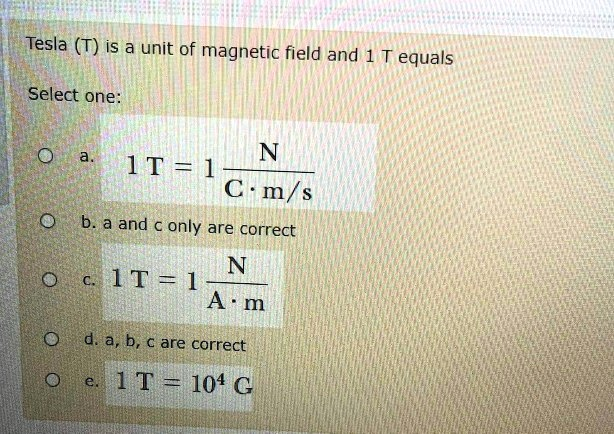Tesla (T) is a unit of magnetic field and 1 T equals Select one: N 1T =1 C.m/s b. a and € only are correct N 1T = 1 A:m a, b, € are correct 1 T= 104 G

The Correct Answer and Explanation is:
Based on the principles of physics, the correct option is d, assuming a typographical error in the option’s text. Here is a detailed explanation:
The question asks to identify the correct equivalent for 1 Tesla (T), the SI unit of magnetic field strength. To determine the answer, we must evaluate each statement.
Statement a: 1 T = 1 N / (C·m/s)
This equivalence is derived from the Lorentz force law, which describes the force (F) on a point charge (q) moving with velocity (v) through a magnetic field (B): F = qvB. By rearranging this formula to solve for the magnetic field, we get B = F / (qv). Analyzing the SI units for each term:
- Force (F) is in Newtons (N).
- Charge (q) is in Coulombs (C).
- Velocity (v) is in meters per second (m/s).
Therefore, the unit for B, the Tesla, is equivalent to N / (C·m/s). This statement is correct.
Statement c: 1 T = 1 N / (A·m)
This equivalence comes from the formula for the force on a straight, current-carrying wire of length (L) in a uniform magnetic field (B): F = ILB. Solving for B gives B = F / (IL). The SI units are:
- Force (F) is in Newtons (N).
- Current (I) is in Amperes (A).
- Length (L) is in meters (m).
Thus, the Tesla is equivalent to N / (A·m). This statement is also correct. It is consistent with statement a because an Ampere is defined as a Coulomb per second (A = C/s).
Statement e: 1 T = 10⁴ G
This is the standard conversion factor between the Tesla (the SI unit) and the Gauss (G, the CGS unit). The Gauss is a smaller unit of magnetic field strength, and the precise conversion is 1 Tesla equals 10,000 Gauss. This statement is correct.
Conclusion
Since statements a, c, and e are all factually correct, the best choice must be the one that includes all of them. Option d reads “a, b, c are correct”. This is almost certainly a typo and was intended to read “a, c, and e are correct”. Option b (“a and c only are correct”) is incorrect because it excludes the valid statement e. Given that a, c, and e are all true, option d is the most comprehensive choice and the intended answer, despite its typographical error.
